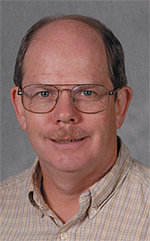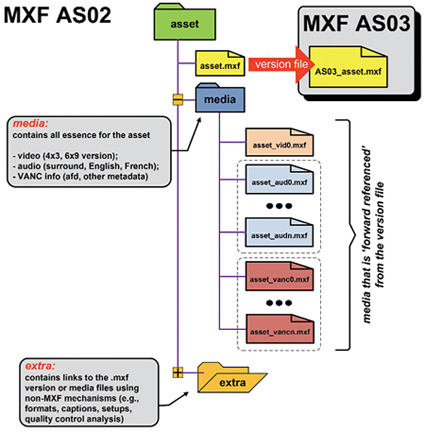Fitting MXF into File-based Workflows

The recent SMPTE Annual Technology Conference and Expo provided some eye-opening demonstrations and thought-provoking applications for the future of file-based workflow.
Storage and content delivery technologies continue to be hot topics, followed closely by IT-based business process management (BPM) and service-oriented architectures (SOA). The applications of storage, servers and content delivery of media were evident in all corners.
SMPTE also showed the emergence of stereoscopic (3D) creation and exhibition for both the home and theater; which seem to be steadily gaining momentum in the media and entertainment industry.
How these file-based applications and processes affect media server and storage technologies, and what we can expect to see going forward will change all of our approaches to workflow over the course of the next decade.
We have already seen real changes in the hardware and software solutions. These changes are especially affecting workflows that we've been accustomed to using for years. Implementing MXF-based solutions that employ application-specific solutions for content creation, transport, archive and delivery are well on their way to widespread acceptance; and in turn will change the way the facility is designed, built, and operated.
MORE WITH LESS
One of the recognized factors affecting the refinements and dynamics of our traditional over-the-air call letter broadcaster continues to be "doing more with less." These fundamental business changes are driving the consolidation of services, most evident in the revitalization toward hubcasting—known also as "hubbing" or centralization of operations.
Of key concern and one continually reflected upon is that of the continued evolutional changes in encoding (i.e., compression) formats. Recording platforms and server-based play-out systems are tightly coupled into the makeup of the physical hardware. As such, media storage and server platforms and formats now play a key factor within the organization.
Making a decision on a particular product usually answers the question on the compression format, and in some cases, how or if they will employ standardized methodologies for file-based workflows, such as those defined around the MXF toolkits.
For a single broadcast entity, stronger control can be give over the selection of formats and workflows versus that of a production or post-production facility where all forms of media, files and formats must be dealt with on a routine basis.

Portrayals of MXF AS02 and AS03, courtesy of AMWA, SMPTE and AmberFin For group broadcasters, who usually implement their "approved technology" across all of their enterprise, handling incremental changes such as adding new stations is taken on a case-by-case basis when and if they arise.
What has come forward in the evolution of MXF and file-based workflows is a solution set, a tool kit of processes that help to set and establish business processes related to storage, media architectures and content delivery platforms.
Today this may not be nearly as complex an issue for the broadcasters as it is for others (e.g., the multichannel video program distributors or MVPDs) who must handle a constant flow of differing media requirements throughout their business channels. This is where some of the solutions presented at SMPTE by Advanced Media Workflow Association (AMWA) and others seem to make good practical business sense.
File-based workflows are inherently coupled to media- and video-server technologies, including editorial platforms. From the point of capture or ingest through production and finally to distribution and archive, the migration of content as files must be carefully managed so as to maintain proper compliance with standards and interoperability among all the systems they may touch.
Today, the growing perspective is to employ software-centric architectures that can operate on commodity serving platforms, a trend that is gaining popularity in all facets of media operations. This fundamental concept is being employed in capture and acquisition, in archive and transcoding, at MVPD play-out centers, and is especially valuable in moderating the impacts on storage when involved with repurposing or versioning of content on a global basis.
Software solutions have made their way into encoders and decoders for mission-critical applications such as play-to-air and ingest servers. For transcoders and processors, these software solutions now reside on conventional high-performance computer platforms (e.g., HP or Dell servers) almost exclusively.
Analysis tools, monitoring, and workflow management applications used for evaluation and scheduling of services are almost exclusively built-in software. Many disaster recovery (DR) sites have utilized low-cost computers and software codecs with simple RAID storage arrays to support the primary sites as hot standby systems. All these applications employ files, and structuring those files is of paramount importance when designing, operating and delivering for a file-based workflow.
NEW TECHNIQUES
The methods we use to evaluate products, and the decision processes that ultimately select a solution are becoming quite different from those techniques used in the yesteryear. Thus the risks we must take in selecting the right product for the right application grow higher as we move from the reliability of hardware-only based platforms to all IT-based implementations.
To offset potential risks, we should employ tool sets that are standards-based and proven to be interoperable while maintaining the flexibility and adaptability without a continual need to replace or upgrade aging hardware platforms.
When your enterprise decides to adopt a 100-percent file-based workflow, then that is the time to get thoroughly immersed into the tool sets that are developed and ready for use.
MXF, which continues to gain a footing since its inception, has been developed and refined into a tool set that integrates essence and metadata driven towards interoperability between both file-based platforms and modern workflow architectures.
What was demonstrated at SMPTE is the outcome of several man-years of dedicated participants who have now employed structured standardized practices to unveil a multitude of products that they can successfully and seamlessly interoperate in an all file-based domain.
The most recent work from AMWA is the output known as MXF AS02 and MXF AS03, and which are based on the 2004 version of MXF.
To summarize in the briefest of descriptions, an 'AS' is an application specification, which constrains the MXF toolkit so as to efficiently carry essence, as pictures, sound and metadata, through the workflow processes intrafacility so as to create deliverables and versioning as needed. The completed MXF AS02 is a "work in process" mastering tool, utilized to enhance interoperability with precise file behaviors, layouts and a specific set of codec ranges.
In this implementation all components of the asset must lie inside a "root folder." One-to-many versions of the asset may be created from the elements of the asset data contained in this root folder and its subfolders as described. The primary version, should it exist, has the name of the root folder. The essence components that consist of audio, video and data, are held in a media subfolder.
Version files are small 10-500 kb MXF files with no essence. The version files are utilized when creating, for example, a Spanish-language version with French subtitles from the same primary video file; or when adding tracks for multilanguage versions assembled for a transport stream multiplex.
The intent of this mastering tool, as MXF AS02, is to minimize the number of physical "versions" that are made up of duplicate video sets coupled with every additional version, whether those are language variations, closed or open caption variations, or graphics variations of the same root, or primary content.
The second application specification is MXF AS03, which is used in the delivery of finished content. It too only uses the 2004 version of the MXF standard. An AS03 asset is always a single file and any custom metadata must be present in that file.
The design of AS03 is such that different sets of applications and users can reliably play back content by employing a set of self-contained metadata sets for content identification and verification in the AS03 file.
AS03 might be used by a content distributor or a network program provider to send the same files to multiple different (compliant) edge servers, and have any of those servers play back the content efficiently and properly. AS03 was set up with specific constraints, such as video in H.264 or MPEG-2 MP or MPEG-2 422P.
AS03 audio must be in PCM pairs, as AC3 or as Dolby E. Closed-captioning data must be carried in a SMPTE 334-1-2007 and 334-2-2007 compliant ANC packet inside a SMPTE 436M-2006 compliant VBI/ANC GC element using 8-bit encoding. In addition, AS03 allows for the inclusion of additional metadata sets to be used in secondary applications, such as program libraries.
This focus on workflow, MXF application specifications (AS) and the emergence of software-based systems that can be deployed on commodity hardware platforms has only touched upon the arrival of what are myriad combinations of uses and applications we can expect to see going forward. Those that are currently planning to move to an all file-based workflow are encouraged to thoroughly investigate and understand just what is required to operate with these formats and tool sets. A very good place to start is via the AMWA, which has provided much of the technical information in this month's column.
Karl Paulsen is chief technology officer for AZCAR Technologies, a provider of digital media solutions and systems integration for the moving media industry. Karl is a SMPTE Fellow and an SBE Life Certified Professional Broadcast Engineer. Contact him at karl.paulsen@azcar.com.
Get the TV Tech Newsletter
The professional video industry's #1 source for news, trends and product and tech information. Sign up below.

Karl Paulsen recently retired as a CTO and has regularly contributed to TV Tech on topics related to media, networking, workflow, cloud and systemization for the media and entertainment industry. He is a SMPTE Fellow with more than 50 years of engineering and managerial experience in commercial TV and radio broadcasting. For over 25 years he has written on featured topics in TV Tech magazine—penning the magazine’s “Storage and Media Technologies” and “Cloudspotter’s Journal” columns.
